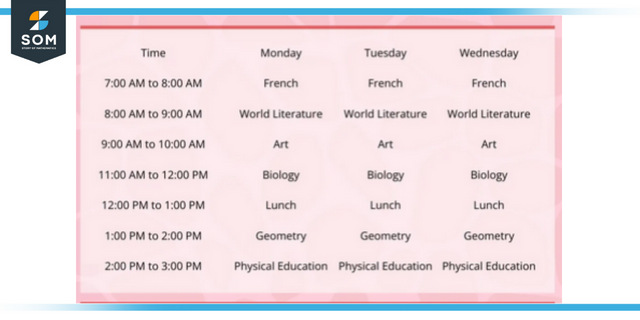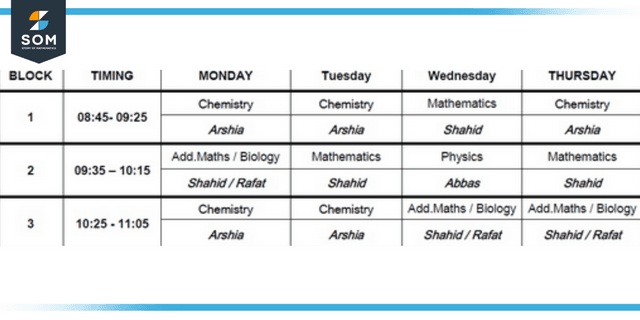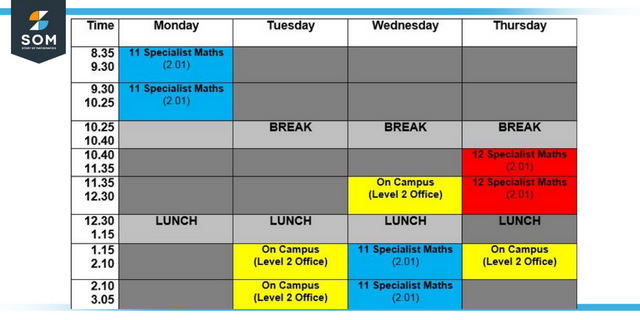JUMP TO TOPIC
- Definition
- What Is a Timetable?
- Requirement of Timetable
- Significance of Timetable
- Usual Content of a School Timetable
- Different Kinds of Timetable
- Availability of Time
- Department Regulation
- Relative Importance of Timetable
- Appearance of Tiredness
- Principles of Variety
- Free Period For Teachers
- Principles of Play and Recreation
- Examples of Working With Timetables
Time Table|Definition & Meaning
Definition
Any table that lists various events against the time of their occurrences is a timetable. It is often used to present schedules. For example, on exam days, we have timetables for the students to know when their exam takes place. They are helpful for planning, organizing, and managing events where lots of things happen over time.
What Is a Timetable?
A thorough plan that outlines the timeline of the amount of time spent on various topics and activities is called a timetable. In most cases, the schedule is predetermined for the entire week and will be repeated. Following the schedule, every assignment is carried out methodically in the classroom. As a result, the timetable is sometimes referred to as the second school clock.

Figure 1: Representation of Time table
Requirement of Timetable
The effective administration of a school’s daily operations requires the utilization of a timetable. Because of this, the school principal is aware of the work being done in each class and by each instructor. The schedule will significantly assist him in completing the tasks that are required of him at school.
Significance of Timetable
- The use of a timetable helps to maintain order in the workplace by minimizing repetition and overlapping.
- Timetable saves both the energy and time of the instructors and students.
- It ensures that the appropriate amount of time is allotted to the various topics and activities.
- It guarantees that the work is distributed fairly among the several teachers.
- It shows that the students and teachers have developed orderliness, firmness, regularity, and awareness habits.
- It contributes to the upkeep of order and discipline.
Usual Content of a School Timetable
- The time at which the school day starts and finishes each day.
- The beginning and ending times of each phase are indicated here.
- The periods allotted to the various topics and activities.
- The days and times on which and during each course and activity must be dealt with have to be determined.
- The name of the instructor who is supervising each subject as well as each activity within the allotted period.
- The name of the instructor who is in control of each segment throughout each period.
- Every class meets in this particular room.
- Specifics on the breaks in the schedule.
Different Kinds of Timetable
There are three distinct formats for the timetable.
Class Timetable
This is intended to be used in the classes.
This will demonstrate how the subjects are distributed. A comprehensive timetable that details the division of topics according to classes ought to be made available.

Figure 2: Representation of Class timetable.
Instructors Timetable
Every instructor must have a duplicate of their work schedule at all times. The class he will instruct throughout each period will be denoted in the appropriate column on this timetable.
Master Timetable
This is the master schedule that accounts for the entirety of the school. This will provide an in-depth look at the activities that take place in a school. It should be possible to get a copy from the principal.
Availability of Time
The schedule is created with the available time in mind, considering factors such as the duration of the school year and the total number of vacation days.
Department Regulation
The length of the school year, as well as its terms, such as when a new academic year begins and when it concludes, as well as the length of the school day and even the number of periods dedicated to each subject, are all determined by the state department of education.
Relative Importance of Timetable
The amount of time spent on a topic ought to be proportional to both the relevance of the topic and the degree of difficulty it presents.
A number of socio-economic factors play a role in determining the value of a subject within the context of a school’s curriculum. As a result, the timetable will accommodate these factors adequately.
Appearance of Tiredness
The creation of the school timetable is impacted in various ways by the factors of exhaustion. During some times of the day and on particular days, children experience weariness. The nature of this phenomenon is not only physical but also physiological. It leads to a noticeable decrease in attention, a loss of interest, and the negative impacts of learning.
Principles of Variety
Experiments have shown that switching up where you sit in a room and how you stand can effectively treat feelings of weakness. It is imposed on the teachers as well as the students. The following are some different ways that variety can be included:
- Except for science practicals, each topic should be held for at most two sessions.
- A single class should be in a different room for the entirety of the school day.
- A single instructor should only be responsible for one session in the same classroom.
- If the topic is covered 2/3 of the time every week, the subsequent periods should be spaced out.
- The periods of physical training, science lab work, and drawing assignments all follow a different pattern.
Building a timetable can help organize and manage the available time to facilitate learning and a reasonable flow of learning for the students.
Free Period For Teachers
We should give free periods to teachers so that they improve their productivity and have time to correct their students’ work, and we should also give them time to relax.

Figure 3: Representation of Teachers Timetable.
Principles of Play and Recreation
To prevent boredom, the schedule should include time allotted for relaxation and recreation, as well as a variety of extracurricular activities, and careful consideration should be given to scheduling these things.
Examples of Working With Timetables
Example 1
The nursery class has a timetable in which they have 7 periods of 30 minutes each from 9 am to 1 pm. Students have their 30 minutes break after 3rd period. At what time will they have their break?
Solution
As each period is of 30 minutes, students will have their break at 10:30 am.
Example 2
The grade 2 class has a timetable in which they have 8 periods of 40 minutes each from 8 am to 2 pm. Students have their 40 minutes break after 4th period. At what time will they have their break?
Solution
As each period is of 40 minutes, students will have their break at 10:40 am.
All images/graphs are created using GeoGebra.
